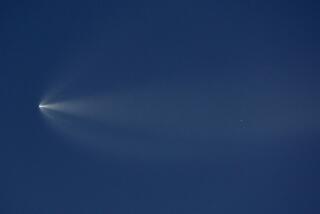Orion capsule makes a ‘bull’s-eye’ splashdown in Pacific

The launch of Orion spacecraft test flight atop a Delta IV Heavy rocket from Cape Canaveral Air Force Station’s Space Launch Complex.
Against the backdrop of a rising sun, NASA’s next-generation Orion space capsule successfully blasted off Friday morning and later landed with a “bull’s-eye” splashdown in the Pacific Ocean.
“Liftoff at dawn, the dawn of Orion and a new era of American space exploration,” said NASA announcer Michael Curie as the capsule, riding atop a powerful Delta IV Heavy rocket, rose into the sky over Cape Canaveral Air Force Station at 7:05 a.m. EST.
Four and a half hours later, his colleague Rob Navias declared the splashdown, 270 miles west of Baja California, a bull’s-eye. “America has driven a golden spike as it crosses a bridge into the future,” Navias said.
The mission began flawlessly, and NASA repeatedly called its readings from the craft “perfect.” Six minutes into the flight, the Delta IV successfully jettisoned its three boosters and the second stage ignited. That stage’s burn ended 18 minutes into the flight as Orion entered Earth orbit.
The launch went off on NASA’s second attempt after wind and technical problems scrubbed a Thursday morning try.
But that was forgotten as the rocket and Orion rumbled into the sky, to the delight of thousands of people along the waterfronts of Brevard County.
“I have always dreamed of being an astronaut,” said Lizzi Gunn, 24, of Kissimmee, Fla., who watched the liftoff from Kennedy Space Center. “I’m so proud of this country for doing it and deciding we are going to Mars.”
The two-orbit unmanned mission gave NASA a chance to test the nation’s new designed-to-do-everything spacecraft. In coming decades, Orion is expected to carry astronauts deep into space to the moon, asteroids, Mars and beyond.
The launch has been touted as the beginning of NASA’s next big thing -- deep space exploration -- culminating in a Mars visit in about 20 years.
“This is Day 1 of the Mars era,” proclaimed NASA administrator Charles Bolden.
At three hours and six minutes into the flight, Orion swung out to its peak height of 3,604 miles above the Earth, higher than any spacecraft designed to carry humans has gone since the days of the Apollo moon missions. A few minutes later, the craft jettisoned the last piece of the Delta rocket and its service module, flying free for the first time.
Shown in spectacular video provided from the capsule itself and a NASA drone, the returning Orion reached a reentry speed of 20,000 mph, deployed three sets of parachutes and splashed down in the ocean four hours and 24 minutes after liftoff.
NASA and Lockheed Martin, which developed the spacecraft, were able to gather much of the data they sought during the flight, but a lot more once Orion is recovered and experts can examine the capsule’s recorders.
The Navy is in charge of recovery. Once that is done, Orion will be taken to Kennedy Space Center, returning before Christmas, officials said.
Orion’s future is contingent on congressional funding. House and Senate appropriation bills now awaiting action include more money for the program than has been requested by President Obama.
After the launch, Sen. Bill Nelson, (D-Fla.), speaking at Kennedy Space Center, predicted that the Orion program will reignite popular excitement about the space program that was lost with the end of the space shuttle program in 2011.
“As they envision Americans being in this spacecraft, the American people will get excited again, and they are already getting excited,” Nelson said.
Orion’s next big test is scheduled for 2018, when NASA’s powerful new rocket, the Space Launch System, is ready. That test is to take another unmanned Orion for a trip around the moon.
The SLS is capable of 8.4 million pounds of thrust, about four times as much as the Delta IV Heavy. Orion and the SLS are expected to be the backbone of NASA’s long-term human space exploration plans.
Bolden said his granddaughter recently reminded him of this long-term potential and vision, telling him: “Don’t get hung up on Mars, because there are other places to go once we get there.”
Marco Santana of the Sentinel staff contributed to this report.
More to Read
Start your day right
Sign up for Essential California for news, features and recommendations from the L.A. Times and beyond in your inbox six days a week.
You may occasionally receive promotional content from the Los Angeles Times.







